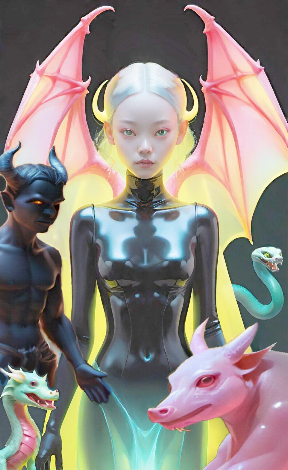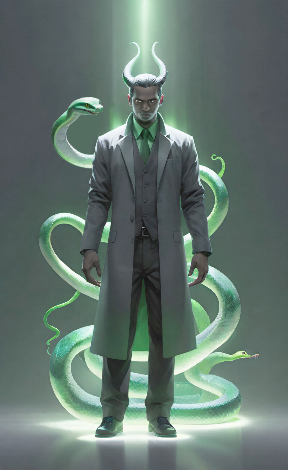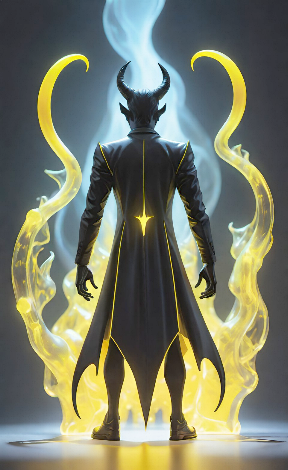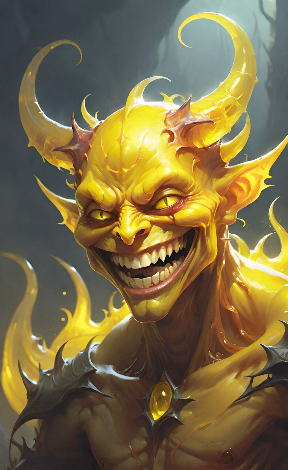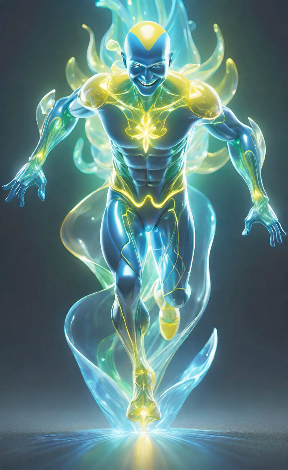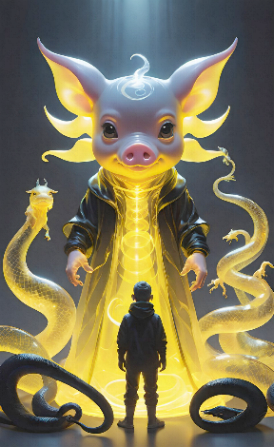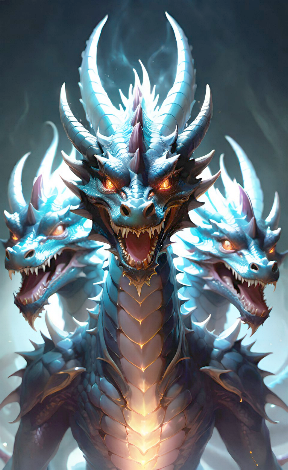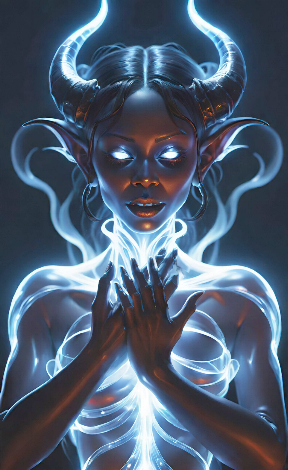Three + Seven Subtle Figures: Angels and Besenwesen-Demons
To become oneself, a person must withstand quite tough competition with various entities that also want to become them. This, unfortunately, is by no means a joke or a metaphor, but a precise statement that, however, needs some comments. Fiends (Troublesome Spirits) or Demons are certain ranks of development and purpose under specific conditions.
When there is no love in life, there is no life in it.
Angels and Fiends-Demons
Any periodically recurring sequence of human actions (both in the external and internal world), which transforms at least to some extent into habit and automatism, forms a subconscious program that governs this automatism, and simultaneously brings to life a certain entity or figure in the subtle world, appearing around the person every time the corresponding subconscious program is activated.
Below we will consider seven characteristic figures (colloquially called Besenwesen), which are mostly located behind a person and feed on the person's vital forces during the activation of certain harmful habits and behavioral patterns.
Moreover, personal subconscious programs characteristic of society as a whole collectively form large, archetypal subtle figures that create and involute corresponding individual subtle figures of individual people.
Thus, each person has two sets of subtle entities that regularly appear around them and directly influence them: the first set consists of figures created personally by them, and are unique; the second consists of general social ones, induced by the social egregore through channels connecting the given person with society. Personal figures consume part of a person's vital force and memory, giving a certain percentage of it to higher ones, and the higher ones to even higher social ones. For completeness of the description, it should be noted that there are also subtle bodily crocodiles that parasitize on a person's subtle bodies: astral, mental, and so on.
Here the website author wants to note immediately that there are very, very many astral entities similar to the «Subtle Seven».
They can be considered as teachers and saviors. By redirecting channels of vital force to themselves (from 10 to 90%), they drain a person of energy during their erroneous actions. In extreme cases, such a power drain can even go so far that the person cannot leave the house. In such instances, the person will not make foolish mistakes and will not harm their physical health, destiny, or the surrounding space.
But the matter does not end there. The attached entity (which can also be a bright angel) begins, as it were, to further educate and train the person, provoking and tempting them into further erroneous (or, conversely, correct) actions or thoughts. Sometimes it even takes control of their behavior. In doing so, the entity acquires part of the person's strength, experience, and memory to earn its future incarnation as a human. This connection process continues until the individual, often through pain, ailments, and problems in their destiny, understands, modifies their imperfect subconscious program, and becomes more independent.
In contrast to the "Subtle Seven," three subtle entities are assigned to a person (one could say, in front): these are the loving soul, the angel-informer, and the personal demon (more about them on the fourth page). These entities correspond to much deeper subconscious programs than the Subtle Seven's vanity, egoism, and so on. And their help, due to its unobtrusive ethics, considering the law of "free will," often becomes imperceptible to the person themselves.
The Subtle Seven
The Gray Man of Doubt and Despair
The Gray Man (parasites on the sexual chakra) corresponds to subconscious programs that cause depression, skepticism, doubt, and despair in a person. The Gray Man doesn't care. He completely absorbs any emotions, enthusiasm, initiative, and energy, without changing in any way, except perhaps growing in size and only asserting his life position, corresponding to the position of the assembly point from which the world is seen half as a lifeless desert and half as a foul-smelling swamp.
The Gray dulls tools, causes spherical and chromatic aberrations in camera lenses, accumulates rounding errors in computers, and makes joints creak, hindering the secretion of synovial fluid. Mental fatigue with a taste of hopelessness is often also a direct result of his influence. It causes a person to reduce concentration and lose contact with the egregore and the tool. The Gray's inner cynicism and his disrespect for the world and humanity allow shoddy work and dullness to permeate the creator's results, which triumph so obviously and mercilessly that it seems impossible to defeat them.
The Serpent - Cynic and Comedian
The next, probably the most difficult figure to understand and manage, is the Serpent, or, judging by the role it most often assumes, the cynic and comedian. The main weapon of the Serpent is irony, which it uses in two ways: firstly, to profane any serious and elevated aspirations of a person (mockery of ideals), and secondly, to divert the owner's attention from dangers threatening them, which the Serpent also portrays as unserious, preventing the person from assessing them and preparing accordingly. The main quality of the images created by the Serpent is inappropriateness, which often produces a comic effect, relieving tension and reducing concentration. The Serpent's task is for a person to give up and stop perceiving the most critical situations for them as serious.
The Serpent, as is its custom, plays the jester, pretending to be all instruments in turn, but especially the enema tube, which it presents as a communication channel with the egregore and the person, represented by their anus. But jokes aside, strong embarrassment is also its doing, and a sudden inability to control one's hands, not to mention tools, and even muscle spasms – all these are often consequences of its activity. And from time to time, to provoke a typist into a nightmare typo, making all editors miss it, it considers not so much a pleasant duty as its direct obligation.
The Black Man of Aggression
The Black Man of Aggression (parasites on the solar plexus center) is created by a subconscious program that controls rigid protection from the external world, and sometimes from attacks on one's ego from within, for example, from a program of duty or conscience. He usually wears a black cloak or a strict suit, is unfriendly, and very reluctantly shows his face, especially his eyes. Their usual expression is distrust and irreconcilability.
The Black Man often creates excessive self-confidence in a person, as a result of which the communication channel with the egregore is completely blocked. A person feels enough strength in themselves to work "on their own," that is, to transmit and materialize the flow of the egoistic egregore – then dilettantism results in the worst sense of the word. In general, the direct feeling of strength and self-confidence at the moment of work are clear signs that a person serves a rigid egregore. A true creator is never completely sure of themselves, their tools, or the level of what they achieve. And the power behind them and their creations is felt by others, but not by themselves, at least not at the moment of work. Inner freedom and doubt in the choice of specific details are eternal companions, and the Black Man tries to deprive a person of both. Even a tram handle should be held with care.
The Gray Man is completely unlike the Black Man: as much as the former is collected, the latter is diffuse, poorly defined.
The Yellow Man of Deception and Self-Deception
The Yellow Man of Deception and Self-Deception (parasites on the heart center) is created by subconscious programs that systematically distort a person's external and internal reality, or, in other words, shift the assembly point into an ethically unacceptable area. Of course, distortions vary, and every meditation and generally any new way of seeing refracts the world in consciousness and subconsciousness in its own way each time, but still there are some positions of the assembly point that either narrow the field of world vision so much or distort this vision so much that upon returning to their normal state, the person denies the former way of seeing, saying that their eyes were misled, that they somehow "accidentally didn't notice what they definitely should have seen," "understood what was happening completely wrongly," and so on.
The Yellow Man tries imperceptibly to shift the assembly point so as to lower the level of materialized egregore vibrations. In cases where a person transmits information to the egregore, the Yellow Man tries to distort it as much as possible to mislead both (the person and the egregore): a writer begins to write a tragedy but falls into a hackneyed melodrama; a believer prepares for fasting and repentance, but mental games with their own ego result; a tightrope walker loses self-confidence and balance... — all these are examples of the Yellow Man's successful machinations.
The Yellow Man largely resembles the Gray Man, and for many people, they act as a peculiar tandem, in the form of a gray-yellow mist swirling at their feet and periodically rising above their heads — a true torment for a psychotherapist.
The Hasty One
The Hasty One (parasites on the throat chakra) represents a being in all respects opposite to the Gray Man, but in fact, their goals are similar — the cessation of energy flow and any constructive human activity.
The main goal of the Hasty One is to increase the rhythm of a person's inner life and external activity. Its motto: "Hurry up, guys, or we won't make it," and what exactly we won't make is completely irrelevant; the main thing is not to stop for a second. The Hasty One participates in any active human activity, be it physical work, thought processes, or speech. At the same time, one of its most important postulates is that the result must be obtained immediately; otherwise, the action is ineffective, and the rhythm must be increased. "Must" is one of the Hasty One's favorite words, but why and for what, exactly, "must," there is no time to understand.
Any slowing down, as well as speeding up of work, must be consistent with the indicated external rhythms, from which The Hasty One tries in every way to distract a person. "Your work has slowed down," it rattles, "and in any case, it's not going fast enough – hurry up, turn all the wheels, gears, and drums, or, even better, switch to something new, for example, you urgently need to..." – and The Hasty One will offer the owner at least five more completely urgent tasks.
The Hasty One is one of the master's main enemies. It doesn't let him finish, that is, listen to the egregore to the end, and also, no less importantly, give the egregore all the necessary information, about which the latter sends the person a special signal like: "Thank you, enough." Instead, the Hasty One starts babbling: "Well, that's enough, that's enough – everything is already clear," and doesn't let, for example, a psychologist listen to a client when they are just beginning to say things that are truly significant to them.
The Hasty One is easily visible by how a person handles tools – quickly and carelessly throwing them into a bag or carefully and slowly putting them away.
The Pig of Egoism
The next figure (parasites on the "third eye") is created by programs of all kinds of lunar consumption — this is the Pig of Egoism. Like all other figures, it has two channels of involution: from the person themselves (the owner) and from the archetypal Great Pig, created in accordance with general social ideas about the necessary, natural, and desirable limits of consumption for a social individual. In addition, the Great Pig has a direct involution from Fokerm.
The Individual Pig of Egoism is primarily formed by the person themselves and the specific social stratum in which they move, and the influence of the Great Pig on personal Pigs is much less individualized than, for example, the influence of the Yellow King on the figures of specific Yellows: if Yellows differ greatly from each other, then the Pigs of people from similar social strata are often very similar: those who are simpler prefer the Ukrainian version of the Pig, under the motto "the more fat, the tastier," while more cultured people tend to gravitate towards English bacon, trying to alternate layers of material and spiritual needs.
The Pig will hinder concentration on work simply because concentration, that is, maintaining the assembly point in a position of connection with a high egregore, is difficult and requires significant effort. Furthermore, it may, for example, tempt a person to treat their tools, and even their bodies, with contempt, even though it seemingly has no interest in doing so. But one should not forget that it is ultimately involuted by Fokerm, and therefore it would be futile to expect consistency from the Pig: it is typical for it, for instance, to make a person eat tasty but admittedly harmful food that will literally cause severe stomach pains within an hour (not to mention smoking and other vices).
The Dragon of Personal Self-Assertion
The last figure is the Dragon of Personal Self-Assertion. Like all other subtle figures described in this chapter, the Dragon is socially induced, meaning the need for personal self-assertion is inherent to a person precisely as a social individual, but not as a spiritual entity.
Nevertheless, society, at least in its current form, needs its members to possess ambition and strive for the social unfolding of their personality. This is one way to make a person work for the good of society. The thirst for social recognition, the desire to collect the maximum number of signs of love, attention, and reverence, the desire for glory – from these seeds, sown by the social egregore, subconscious programs grow in a person, bringing the Dragon of self-assertion to life.
The Dragon can activate any of its heads. The **search head** will start looking for someone who will duly appreciate the perfection of a person's work operations — and the latter will immediately be distracted, lose connection, make a mistake in movement — and the engraving is ruined. The **proud head** will think to itself: "How wonderfully I work," — and the turner's hand will tremble. The **complexed head** will whisper to the pendulum master: "How can you determine such subtleties?"
A large, well-fed Dragon, on which the owner comfortably rides, means that the person has revealed their personality to society and received full approval — this is the variant of a popular artist.
Levels of Power of the Subtle Seven
The level of power of Demons over a person and their current state can be assessed by their size. For example, let's take the Black Man:
- The Black Man stands at some distance behind and is of small stature — normal position;
- The Black Man is shorter than the person, but stands in front and gestures slightly — socially acceptable aggression;
- Waving fists — stepping outside social norms;
- The Black Man stands behind the person, taller than them, and holds their hands on their shoulders, or, worse, on their throat — partial role reversal. Then the person listens to the Black Man against their will and ethics. For example, periodically uncontrolled outbursts of rage or quasi-epileptic seizures of "hysterical" origin;
- The Black Man has completely absorbed the person, so that the latter's face is barely visible. This person is a puppet of a rigid aggressor and virtually devoid of their will — fanatics, aggressive antisocial elements, periodic visitors to psychiatric hospitals;
- The Black Man is tall, completely absorbs the person so they are barely visible, and has a clear channel to the Black King — completely antisocial personalities, maniacs, total madmen, not necessarily violent — a variant of all-consuming terror of the world is possible.
Many diseases are clearly linked to the accentuation of one of the seven subtle figures and its penetration into the human body, and here the author, with apologies for intruding into the professional medical egregore, wants to give some examples:
Diseases of the Dragon — peptic ulcer disease, vegetative-vascular dystonia;
Diseases of the Pig — atherosclerosis, gout, kidney stones, and gallstones;
Diseases of the Hasty One — thyrotoxicosis, tic, neuroses, Parkinson's disease;
Diseases of the Yellow Man — allergies, diabetes, metabolic disorders;
Diseases of the Black Man — migraine, hypertension, heart attack, stroke;
Diseases of the Serpent — impotence, ovarian dysfunction;
Diseases of the Gray Man — asthenia, osteochondrosis, sciatica, arthritis.
